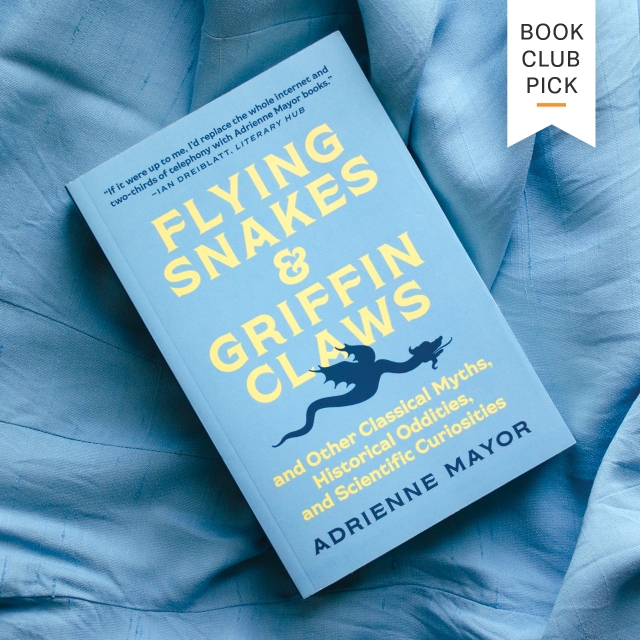Adrienne Mayor is renowned for exploring the borders of history, science, archaeology, anthropology, and popular knowledge to find historical realities and scientific insights—glimmering, long-buried nuggets of truth—embedded in myth, legends, and folklore. Combing through ancient texts and obscure sources, she has spent decades prospecting for intriguing wonders and marvels, historical mysteries, diverting anecdotes, and hidden gems from ancient, medieval, and modern times. Flying Snakes and Griffin Claws is a treasury of fifty of her most amazing and amusing discoveries.
Discussion Questions
- Mayor presents an interdisciplinary approach to classical mythology that bridges the gaps between folklore, archaeology, and natural science, “searching for genuine knowledge embellished with imagination.” What do you think of her unique methodology? Do you think it is beneficial to other scholars in these fields?
- Mayor paints fun vignettes of her pet ferrets over the years. Do you have an uncommon house-pet? Have you ever considered their ancient roots and significance?
- There are several entries that discuss the contributions that historically underrepresented people have made to both mythological and scientific inventions. For instance, in Chapter 7: “A Little Bird with Poison Poop, Mayor shares that indigenous peoples actually knew about the toxicity of the Pitohui bird long before others claimed to discover it in 1989. In Chapter 36: “The First Anti-Vaxxers,” she also describes how enslaved Africans contributed to the development of immunity to smallpox. Drawing from these examples, do you think there are ever instances in which a certain person or set of people own research, findings, and/or knowledge? If so, how should this be determined and how do we ensure that the proper person/people are credited?
- Referring to her, often frustrating, research on ancient griffins, Mayor writes, “But it just didn’t seem fair that scholars willing to give so much credit to the Greeks for inventing democracy, philosophy, and catapults could give the same people a D- in paleontology” (121). What does this say about the field of classics and ancient history? Do you think it can / should expand in this way?
- There are various accounts of the life of Chiomara, a Celtic woman living during the Galatian War. How do we balance between ensuring that ancient women are given proper narratives and prominence and also avoiding the exaggeration and inaccuracy Mayor reveals here?
- Do you think Amazon-like women really existed in antiquity? Does it matter if they did? Why does this discourse matter?
- From creating fake fossils and comparing drinking cups to women’s breasts to judging others’ personalities based on physical appearances, Mayor shows how ancient these human behaviors are. Do you find these commonalities concerning or comforting?
- When did international travel to Greece first become popular? Today, Greece’s economy depends heavily upon its tourism industry. Why do you think that Greece has remained so appealing to tourists and travelers?
- Has reading this book changed your thoughts about or your approach to classical mythology and/or natural history? If so, how?
- What was the most fascinating oddity to you and why?
About the Author
Adrienne Mayor’s books include The Poison King: The Life and Legend of Mithradates, Rome’s Deadliest Enemy, which was a finalist for the National Book Award, Gods and Robots: Myths, Machines, and Ancient Dreams of Technology, and The Amazons: Lives and Legends of Warrior Women across the Ancient World (all Princeton). She is a research scholar in classics and the history of science at Stanford University.

